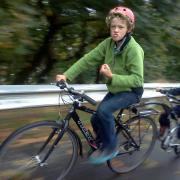Creating a Framework for GIS Mapping in Safe Routes to School
 As Safe Routes to School programs have increased across the country, a clear need for better data management at the national level has become apparent. Many communities have used Geographic Information System (GIS) mapping in assessments of the built environment, but because there is not a central place to store data, this information is stuck, in a sense, at the local level.
As Safe Routes to School programs have increased across the country, a clear need for better data management at the national level has become apparent. Many communities have used Geographic Information System (GIS) mapping in assessments of the built environment, but because there is not a central place to store data, this information is stuck, in a sense, at the local level.
Hurricane Sandy and Safe Routes to School
 We have had a lot to be thankful for recently, excepting the lasting and tragic human impact of hurricane Sandy.
We have had a lot to be thankful for recently, excepting the lasting and tragic human impact of hurricane Sandy.
Safe Routes to School = Good Health = Good Economy
 We travel just over two miles to school each day with our two boys - by bike, of course, most days. I am proud that my ten-year old son is now riding his six-year old brother to school on a tag-along! Both boys insist on it now. This picture shows the Big Guy showing off his tough guy face on a recent school trip.
We travel just over two miles to school each day with our two boys - by bike, of course, most days. I am proud that my ten-year old son is now riding his six-year old brother to school on a tag-along! Both boys insist on it now. This picture shows the Big Guy showing off his tough guy face on a recent school trip.
So Many Resources, So Little Time: Announcing a New Library of Resources
 Co-authored with Kathy Cooke, network coordinator - One of the most common interests shared by staff at the Safe Routes Partnership is a love of books. Reading books, belonging to book clubs, haunting book stores when we're not working -- you name it.
Co-authored with Kathy Cooke, network coordinator - One of the most common interests shared by staff at the Safe Routes Partnership is a love of books. Reading books, belonging to book clubs, haunting book stores when we're not working -- you name it.
Hawaii Creates New Safe Routes to School Funds!
 This month has been a tough one for Safe Routes to School supporters.
This month has been a tough one for Safe Routes to School supporters.
Tell Me A Story, Not A Statistic
 Last week I was in a communications training with other nonprofit groups - a really good one, by the way, from Spitfire Communications, sponsored by the Robert Wood Johnson Foundation. We were tasked throughout the week with writing stories, creating elevator speeches and developing communications plans. I learned a lot.
Last week I was in a communications training with other nonprofit groups - a really good one, by the way, from Spitfire Communications, sponsored by the Robert Wood Johnson Foundation. We were tasked throughout the week with writing stories, creating elevator speeches and developing communications plans. I learned a lot.
Want to See More Women on Bikes? Get Girls on Bikes!
 In the US, men's cycling trips surpass women's by at least 2:1. So how do we change that? We start by simply inviting women to participate. On May 13, there were 163 women-focused rides in 14 countries, including the US.
In the US, men's cycling trips surpass women's by at least 2:1. So how do we change that? We start by simply inviting women to participate. On May 13, there were 163 women-focused rides in 14 countries, including the US.






